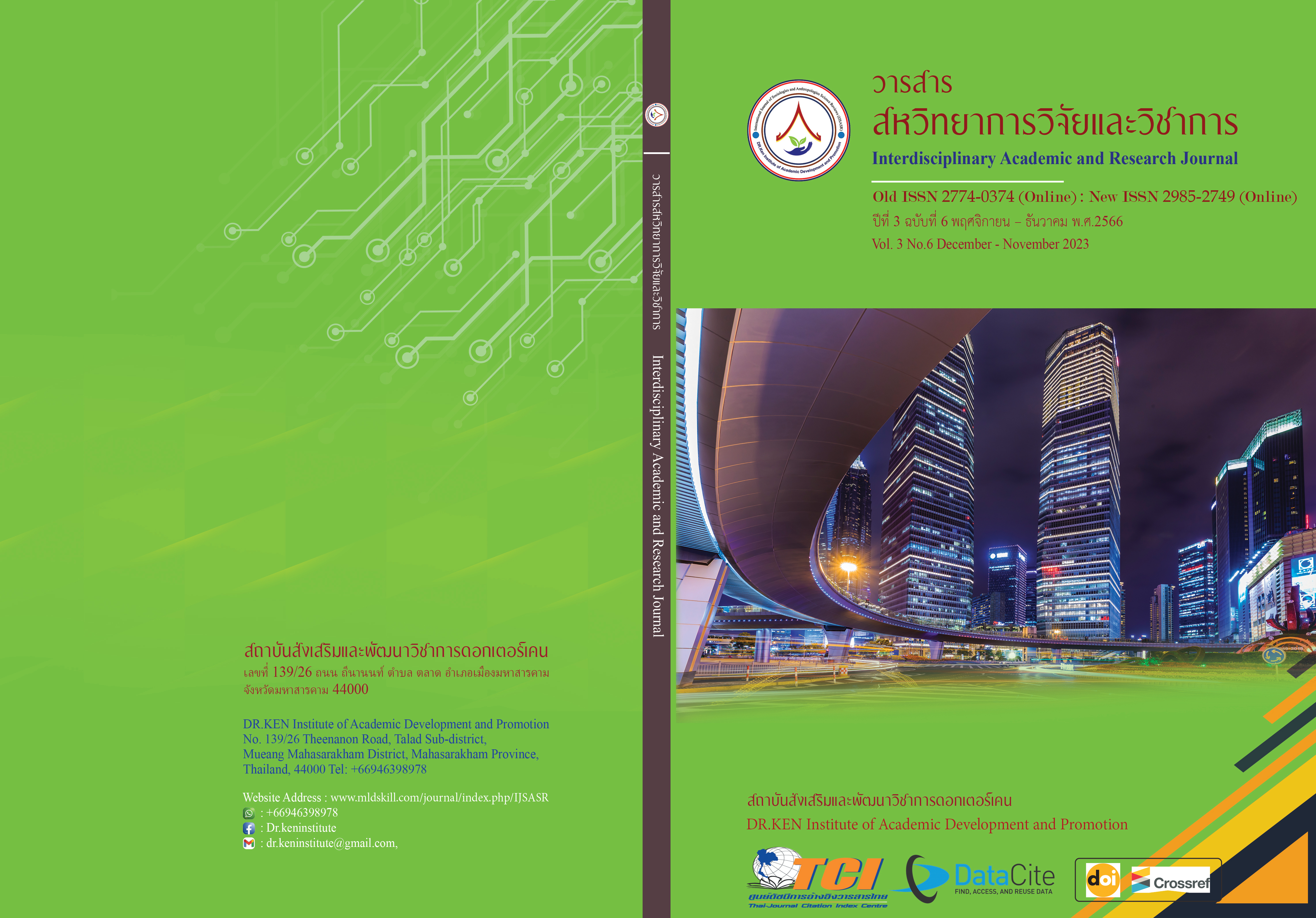Mathematical Concept Study the Ability to Use Symbols and Algebraic Operations that Affect Mathematical Problems in Fractions of 1st-Grade Students
DOI:
https://doi.org/10.60027/iarj.2023.271254Keywords:
Mathematical Concepts; , Ability to Use Symbols;, Algebraic Operations; , Stock Exchange of ThailandAbstract
Background and Aims: Mathematics is one of the learning subjects that is mainly used for teaching students to provide students with an understanding of the principles and structure of mathematics. Have mathematical skills and processes Have a good attitude towards mathematics. Recognize the value of mathematics. As well as creating a correct concept which will indicate that students understand the content studied well. and can be used to solve problems effectively Therefore, this research is a study of mathematical concepts. Ability to use symbols and algebraic operations that affect mathematical problems. The objectives are as follows: (1) to study the concepts of mathematics Ability to use symbols in algebraic operations and mathematical problem solving (2) to study mathematical concepts and the ability to use symbols and (3) to find ways to develop mathematical concepts. Ability to use symbols and algebraic operations that affect mathematical problems.
Methodology: The sample consisted of 210 Mathayomsuksa 1 students at Sarakhampittayakom School. The research instruments were mathematical concept tests. Symbol use tests algebraic operations and solves mathematical problems regarding linear equations with one variable. The statistics used in the research were mean and standard deviation. Analysis of written work and presentation using descriptive and analytical methods.
Results: (1) The majority of mathematical concepts were at moderate levels, most of the ability to use mathematical symbols were at moderate levels, most of the algebraic operations were at medium level, and most of the mathematical problem solving were at medium level. (2) The concept and ability to use mathematical symbols and the algebraic operations affecting most mathematical problems were moderate. And (3) guidelines for developing mathematical concepts the ability to use symbols and Algebraic operations that affect mathematical problem solving are based on thinking and analytical learning. Practice converting text from problems to symbols. Getting students familiar with Problem-solving steps allows students to encounter new situations to train students to develop problem-solving skills. And practice linking knowledge from various situations that have been encountered.
Conclusion: Most math concepts have a moderate ability to use symbols, perform algebraic operations, and solve problems. The development approach is for students to practice problem-solving skills and connect knowledge from various situations through the process of thinking and analyzing.
References
กระทรวงศึกษาธิการ. (2552). หลักสูตรแกนกลางการศึกษาขั้นพื้นฐาน พุทธศักราช 2551. กรุงเทพฯ : โรงพิมพ์ชุมนุมสหกรณ์การเกษตรแห่งประเทศไทย.
ปริฉัตร์ จันทร์หอม. (2555). ผลของการจัดกิจกรรมการเรียนรู้คณิตศาสตร์ตามแนวคิดแบบฮิวริสติกส์และโมเดลเมธอดที่มีต่อความสามารถในการคิดเชิงพีชคณิตและความสามารถในการแก้ปัญหาคณิตศาสตร์ของนักเรียนมัธยมศึกษาปีที่ 1. วิทยานิพนธ์ปริญญาครุศาสตรมหาบัณฑิต :จุฬาลงกรณ์มหาวิทยาลัย.
พร้อมพรรณ อุดมสิน. (2544). การวัดและการประเมินผลการเรียนการสอนคณิตศาสตร์. กรุงเทพฯ : บริษัท บพิธการพิมพ์ จำกัด.
สถาบันส่งเสริมการสอนวิทยาศาสตร์และเทคโนโลยี. (2555). ทักษะและกระบวนการทางคณิตศาสตร์. กรุงเทพฯ : 3-คิว มีเดีย.
สมทรง สุวพานิช. (2549). โจทย์ปัญหาคณิตศาสตร์ ทฤษฎีและการปฏิบัติ. มหาสารคาม : มหาวิทยาลัยราชภัฏมหาสารคาม.
สิรีรัตมิ์ ผลขวัญโชติกา. (2554). ผลของการจัดกิจกรรมการเรียนรู้โดยใช้รูปแบบการเรียนการสอน 4EX2 ที่มีต่อมโนทัศน์และความสามารถในการแก้ปัญหาคณิตศาสตร์ของนักเรียนชั้นมัธยมศึกษาปีที่ 3. วิทยานิพนธ์ปริญญาครุศาสตรมหาบัณฑิต : จุฬาลงกรณ์มหาวิทยาลัย.
อรญา อัญโย. (2553). ผลของการจัดกิจกรรมการเรียนรู้คณิตศาสตร์โดยบูรณาการการใช้ตัวแทนที่หลากหลายและเครื่องคำนวณเชิงกราฟที่มีต่อมโนทัศน์ทางคณิตศาสตร์และความสามารถในการแก้ปัญหาทางคณิตศาสตร์เรื่องฟังก์ชัน. วิทยานิพนธ์ปริญญาครุศาสตรมหาบัณฑิต : จุฬาลงกรณ์มหาวิทยาลัย.
อัมพร ม้าคนอง. (2536). การวินิจฉัยข้อผิดพลาดทางการเรียนคณิตศาสตร์ ของนักเรียนชั้นมัธยมศึกษาปีที่ 5 โรงเรียนสาธิตจุฬาลงกรณ์มหาวิทยาลัย. กรุงเทพฯ : จุฬาลงกรณ์มหาวิทยาลัย.
อัมพร ม้าคนอง. (2557). คณิตศาสตร์สำหรับครูมัธยม. กรุงเทพฯ : จุฬาลงกรณ์มหาวิทยาลัย.
Booker, G. (2009). Algebraic Thinking: generalizing number and geometry to express patterns and properties succinctly. Griffth University.
Cai, J. (2004). Developing Algebraic Thinking in the Earlier Grades: A Case Study of The Chinese Mathematics Curriculum. The Mathematics Educator 8.
Fisher, R. (1987). Problem Solving in Primary School. Great Britain: Basil Blackwell.
Herbert, K., & Browm, R.H. (1997). Patterns as tools for Algebraic Reasoning. In Algebraic thinking. Grades K – 12: Reading from NCTM’s School–Based Journals and other Publications. Edited by Barbara Moses.
Lester, F.K. (1977). Ideas about Problem Solving: A Look at Some Psychological Research. Arithmetic Teacher.
National Council of Teachers of Mathematics. (1989). Curriculum and evaluation standards for school mathematics. VA: NCTM
National Council of Teachers of Mathematics. (2000). Principles and standards for school mathematics. Reston, VA: National Council of Teachers of Mathematics.
Polya, G. (1973). How to solve it. 2nd Edition. New York: Doubleday.
Downloads
Published
How to Cite
Issue
Section
License
Copyright (c) 2023 Rachawadee Khrueangwicha, Ramnaree Nontapa

This work is licensed under a Creative Commons Attribution-NonCommercial-NoDerivatives 4.0 International License.
Copyright on any article in the Interdisciplinary Academic and Research Journal is retained by the author(s) under the under the Creative Commons Attribution-NonCommercial-NoDerivatives 4.0 International License. Permission to use text, content, images, etc. of publication. Any user to read, download, copy, distribute, print, search, or link to the full texts of articles, crawl them for indexing, pass them as data to software, or use them for any other lawful purpose. But do not use it for commercial use or with the intent to benefit any business.
















.png)


